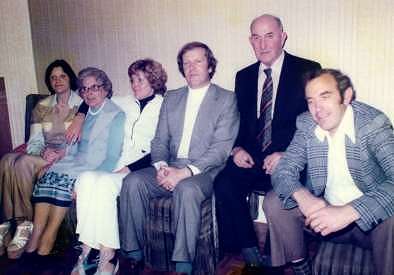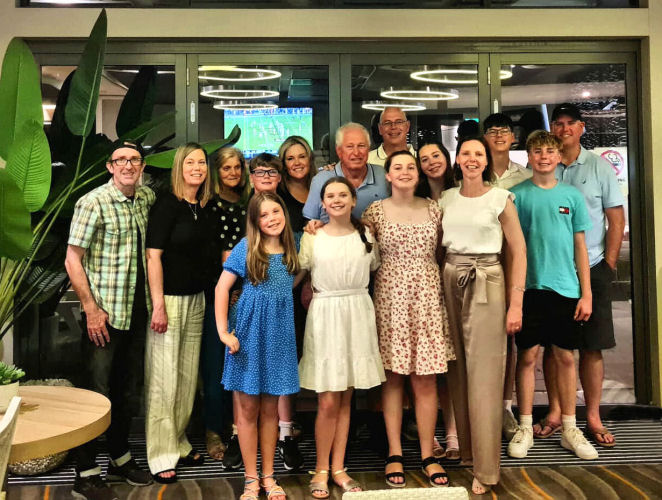Margaret Coleman - 1966
1st Generation Australian Margaret Coleman - Sydney 1966
Margaret Coleman - Sydney 1966
Four of the children born to Pat and Norah Coleman of Cahermaculick, Shrule, Co Mayo, Ireland settled in Sydney in the 1950's and 60's:
Michael (Mick) (1933) in 1957 after two years in North Queensland; Martin (1937) in 1958 and Delia (1942) and Margaret (1945) in 1966.

Norah (1906) & Pat Coleman (1903) - 1933

Generation 6 (G6) of our family tree in Clan Coleman lists the children born to Pat and Norah Coleman. Margaret comes in as the seventh child and third daughter born on 16th January, 1945. When she completed her formal education, she worked in Castlebar, County Mayo, Ireland. In 1963, she joined her sisters Maureen and Delia in London. After three enjoyable years working with Delia in London for the London Barling Pipe Company, they both flew into Sydney in June 1966 where, apart from a short period in Melbourne, they have stayed ever since.
Sydney's famous Opera House was still under construction in 1966. The city's population had just reached three million, and while its skyline was not as tall as it is today, it was already on its way to becoming a modern city. Many Australian had begun questioning the old established ways and the Colonial mentality that had for years been demonstrated and promoted by a long-serving conservative government led by Sir Robert Menzies who retired in 1961. Many of the changes to follow in society, culture and the economy started in the movements of the 1960's. Women continued their campaign for independence and equality, and First Nations people continued to place recognition of land and economic rights on the agenda.
First Nations peoples saw significant change when they were granted the right to vote at national elections in 1962. That same year, Jimmy Little co-founded the 'All Coloured Show', a tour of First Nations artists, performing at hotels and clubs across New South Wales that otherwise banned or segregated people of colour. Charles Perkins, along with other University of Sydney students, visited regional Australia as part of the Freedom Rides in 1965 to gather information about the segregation of First Nations peoples. In the 1967 referendum, the Australian people voted overwhelmingly in favour of the National Government taking over Indigenous policy from state and territory governments, and of First Nations people being from now on counted in the census.
As the Vietnam War continued to escalate, Australian advisers, then troops and conscripts were sent to Vietnam to support South Vietnam’s fight against the Communist north, and in support of the American-led efforts there. As a young high school teacher at the time, I could see the very real impact of the government-enforced ballot conscription system on the young year 12 male students. Like me, they saw it as heavy-handed, un-Australian and undemocratic, and the cause of much anxiety and stress to them and their families.
1966 saw the first visit to Australia by an American President, Lyndon B. Johnson. While it led to large street gatherings to welcome him and show support for America in the world, opposition to Australia’s involvement in the war was certainly growing. The Preident's visit to Sydney is best remembered for its theme of "All the way with LBJ' and the Premier Robert Askin's quip or jibe 'Drive over the bastards' when confronted by demonstrators. Conscription of Australian men to fight in Vietnam became unpopular, as too did the war itself with the first televised images of the impact of war on the people seen in lounge rooms around the nation.
The strong support for the 'White Australia Policy' had begun to wane despite the conservative National Government wanting to attract (mostly British) migrants. Its set of twelve films created to attract migrants from Europe lacked inclusiveness; anything that did not fit into the perceived perfect image of things Australian was left out.
In the 1960's, youth culture was marked by the rise of rock and roll, the popularity of hippie fashion as well as the growing influence of th counter culture movement as the city's nightlife grew more vibrant offering a range of musical styles. With the 60's came the rise of surf culture in Sydney as the sport of surfing became more popular. This decade also saw the emergence of new art movements, such as Pop Art and Minimalism, and the development of new forms of media, such as television and film. This was a time of great creativity, with many artists, musicians, and filmmakers pushing the boundaries of their respective fields.
After leaving Ireland, Margaret and Delia worked together in London, came to Sydney together in 1966, and Lived together until Margaret got married in 1973. Shortly after arriving in Sydney, they became affectionately known as the 'Coleman Twins'. On 3 June, 1973, Margaret married Patrick (Pat) Halpenny from Deerpark, Rosslea, County Fermanagh, Ireland.

James & Margaret Halpenny 1939
Pat was born to James and Margaret (Peggy) Halpenny from Deerpark on 18th September, 1947. He worked in England for two years before arriving in Sydney on 2nd October, 1970. Margaret and Pat have three children: Amanda born in 1974, Adrian in 1976 and Colum in 1979.
2nd Generation

Margaret (1945) & Pat (1947) with Daughter Amanda(1974), Son Colum (1979)
and Son Adrian (1976) & his Wife Raelee (1975)
3rd Generation
|
2024
|
2024 |
2024
|
2024 Three Generations: Margaret & Pat Halpenny with their Children and Grandchildren |
 Margaret & Pat Halpenny with their Children's Families |
4th Generation
Special prize awaits the one to claim this space!
Back to Family Centres - Forward to Sydney Page 5 ( Declan O'Reilly)
 Clan Coleman
Clan Coleman


